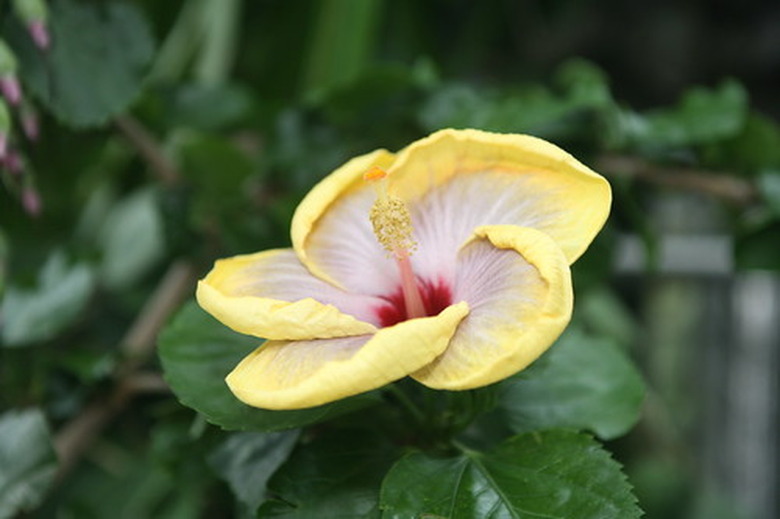What Does A Hibiscus Tree Look Like?
There are dozens of species of hibiscus trees and shrubs, which share a common trait of large, colorful flowers. Some of the more well-known hibiscus trees can be distinguished by their height, leaves and flower color.
Hibiscus Brackenridgei
Growing in the wild to heights of up to 30 feet, this tropical hibiscus isn't likely to reach more than 15 feet in the garden. Its flowers, the state flower of Hawaii, are yellow with a maroon center and grow 4 to 6 inches wide.
Hibiscus Kokio
Known as St. John's rosemallow, this tree reaches heights of 10 to 20 feet and has oblong leaves covered with stiff, branched hairs. Its flowers have orange or yellow petals.
Hibiscus Arnottianus
This tree's white, pinwheel-shaped flowers give it the common name of Hawaiian white hibiscus. It grows to heights of 15 to 20 feet and produces smooth, oval-shaped leaves.
- There are dozens of species of hibiscus trees and shrubs, which share a common trait of large, colorful flowers.
- Known as St. John's rosemallow, this tree reaches heights of 10 to 20 feet and has oblong leaves covered with stiff, branched hairs.
Hibiscus Syriacus
Hibiscus syriacus, or Rose of Sharon, is a hardy hibiscus tree or shrub that grows to approximately 8 feet in height with 3-inch-long, three-lobed leaves. The Ohio State University Department of Horticulture and Crop Science describes its 4-inch-wide, single- or double-flowering blossoms as "very showy," and says they can come in the colors of white, red, purple, mauve, violet or blue, depending on the cultivar.
Hibiscus Rosa-Sinensis
The large, red flowers of this shrub or tree have earned it the common name of red hibiscus. It grows to heights of 15 feet.
Hibiscus Tree?
The hibiscus tree produces trumpet-shaped flowers that come in white, yellow, peach, pink, red, purple, blue or lavender. These blooms can grow as large as 6 inches in diameter. The deciduous hibiscus tree has dark green leaves that develop in the spring. Growing the most robust hibiscus tree means finding a spot in your yard that receives full sun. The tree also requires well-drained soil with a rich humus content, although it can tolerate a wide variety of soil types. Hibiscus trees can grow as much as 8 to 12 feet tall and 6 to 10 feet wide. When mature, the tree takes on a vase-like form. While the hibiscus tree is relatively free of serious problem, it may develop leaf spots, rusts, canker or blights, so watch out for these issues. You can transfer seedlings to containers and replant them elsewhere.
- The hibiscus tree produces trumpet-shaped flowers that come in white, yellow, peach, pink, red, purple, blue or lavender.
- While the hibiscus tree is relatively free of serious problem, it may develop leaf spots, rusts, canker or blights, so watch out for these issues.
Hibiscus Tree?
The hibiscus tree produces trumpet-shaped flowers that come in white, yellow, peach, pink, red, purple, blue or lavender. These blooms can grow as large as 6 inches in diameter. The deciduous hibiscus tree has dark green leaves that develop in the spring. Growing the most robust hibiscus tree means finding a spot in your yard that receives full sun. The tree also requires well-drained soil with a rich humus content, although it can tolerate a wide variety of soil types. Hibiscus trees can grow as much as 8 to 12 feet tall and 6 to 10 feet wide. When mature, the tree takes on a vase-like form. While the hibiscus tree is relatively free of serious problem, it may develop leaf spots, rusts, canker or blights, so watch out for these issues. You can transfer seedlings to containers and replant them elsewhere.
- The hibiscus tree produces trumpet-shaped flowers that come in white, yellow, peach, pink, red, purple, blue or lavender.
- While the hibiscus tree is relatively free of serious problem, it may develop leaf spots, rusts, canker or blights, so watch out for these issues.
References
- National Tropical Botanical Garden
- Utah State University Extension: Hibiscus
- Arbor Day Foundation: Rose-of-Sharon, Hibiscus Syriacus
- National Gardening Association: Hibiscus
- Missouri Botanical Gardening: Hibiscus Syriacus
- University of Florida Extension: Insect Problems of Hibiscus
- Utah State University Extension: Hibiscus
- Arbor Day Foundation: Rose-of-Sharon, Hibiscus Syriacus
- National Gardening Association: Hibiscus
- Missouri Botanical Gardening: Hibiscus Syriacus
- University of Florida Extension: Insect Problems of Hibiscus
